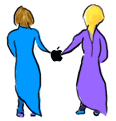|
Q. Will the Mac OS handle the year 2000 correctly?
A. Yes. All Mac OS date and time utilities have correctly handled the year 2000 since the introduction of the Macintosh computer. The original date and time utilities (introduced with the original Macintosh 128K computer in 1984) used a long word to store seconds, starting at January 1, 1904. This approach means that the last date that can be represented correctly is 6:28:15 A.M. on February 6, 2040. The current date and time utilities, documented in Inside Macintosh: Operating System Utilities, use a 64-bit signed value, which covers dates from 30,081 B.C. to 29,940 A.D. For further reference, see Inside Macintosh: Operating System Utilities.
All localized versions of the Mac OS include Gregorian calendar support. In addition, the Arabic version of the Mac OS supports both the Arabic astronomical lunar calendar and the Arabic civil lunar calendar. The Hebrew version of the Mac OS supports the Jewish calendar. The Persian version of the Mac OS supports the Iranian national calendar.
Q. Will Macintosh software handle the year 2000?
A. In general, yes. The only problems encountered have been with developers who used their own date and time utility packages instead of the Toolbox calls supplied by the Mac OS. If you're using your own date and time utilities, you should test your software carefully to ensure that it handles all of the subtle issues of date and time conversion.
Q. What about the year 2019?
A. The Date & Time control panel constrains user input to dates between January 1, 1920, and December 31, 2019. This feature was added for compatibility with the original Macintosh System 6 General control panel, which limited dates so that there would be no ambiguity about a two-digit year (which was all that was normally displayed on a U.S. system). The Date & Time control panel uses the Script Manager function ToggleDate. In 1989, Apple enhanced ToggleDate to include an option that limits dates to the 1920-2019 range so that ToggleDate could be used by the General control panel and other control panels that had a date widget that operated in the same way. You can set a date beyond 2019, up to the year 2040, by using the Macintosh Toolbox function SetDateTime.
Q. Does February 29, 2000, exist?
A. Yes, according to the rules governing leap years, there will be a February 29, 2000. The Gregorian calendar is a solar calendar that measures time from the year of the birth of Jesus Christ. It contains 11 months with fixed lengths of 30 or 31 days and a twelfth month of 28 days that is lengthened to 29 days every fourth year (called a leap year).
The Gregorian calendar is a refinement of the Julian calendar, established in ancient Rome. The Julian calendar assumed a year of 365.25 days. The actual length of the solar year, however, is 365.2422 days, which produces an error of one day every 128 years. In 1582, Pope Gregory XIII adjusted the error that had accumulated over the centuries by canceling the ten days between October 5 and October 15. He further ordained that years divisible by 100 would not be leap years unless they were also divisible by 400. (From this rule, you can see that 1800 and 1900 are not leap years, but 2000 is.) This adjusted the Gregorian calendar to 365.2425 days and reduced its error to one day in 3,323 years. Many non-Catholic cultures adopted the Gregorian calendar over the succeeding centuries, calling Julian dates Old Style and Gregorian dates New Style. This change occurred in the United Kingdom and its colonies in 1752.
|
|
